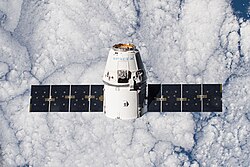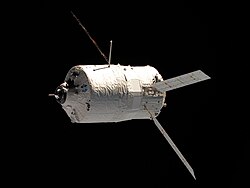Boeing Orbital Flight Test
| Boe-OFT | |||
 | |||
| Statistik för uppdraget | |||
|---|---|---|---|
| NSSDC-ID | 2019-094A[1] | ||
| Farkostens namn | CST-100 Starliner | ||
| Varaktighet | 2 dagar, 1 timme, 21 minuter, 19 sekunder | ||
| Uppskjutning | |||
| Raket | Atlas V N22 | ||
| Uppskjutningsramp | Cape Canaveral LC 41 | ||
| Uppskjutning | 20 december 2019, 11:36:43 UTC | ||
| Landning | |||
| Landning | 22 december 2019, 12:58:02 UTC | ||
| Landningsplats | White Sands Missile Range | ||
| Kronologi | |||
| |||
Boeing Orbital Flight Test (Boe-OFT) är det första obemannade testet av rymdfarkosten CST-100 Starliner i omloppsbana runt jorden.
Farkosten sköts upp med en Atlas V-raket, från Cape Canaveral Air Force Station LC 41, den 20 december 2019.
Strax efter att farkosten separerat från raketen uppstod problem, en automatisk justering av farkostens omloppsbana uteblev och efter att den beordrats från marken och genomförts hade farkosten förbrukat så pass mycket av sitt bränsle att en dockning med rymdstation ISS, var utesluten.[2]
Under tiden farkosten befann sig i omloppsbana runt jorden upptäckte man ett fel i den sekvens som skulle separera servicemodulen från kapseln strax före återinträdet i jordens atmosfär. Om felet inte åtgärdats, så hade servicemodulen kunnat kollidera med kapseln efter att de båda separerat.
Den 22 december 2019 landade farkosten på White Sands Space Harbor.
Efterspel
Den 6 april 2020 meddelade Boeing att man kommer göra ytterligare en obemannad testflygning av farkosten.[3]
Källor
- Den här artikeln är helt eller delvis baserad på material från engelskspråkiga Wikipedia, Boeing Orbital Flight Test, 20 december 2019.
- ^ ”NASA Space Science Data Coordinated Archive” (på engelska). NASA. https://nssdc.gsfc.nasa.gov/nmc/spacecraft/display.action?id=2019-094A. Läst 29 mars 2020.
- ^ Boeing (20 december 2019). ”Boeing Update on Starliner Orbital Flight Test” (på engelska). Boeing. Arkiverad från originalet den 20 december 2019. https://web.archive.org/web/20191220181417/https://starlinerupdates.com/boeing-update-on-starliner-orbital-flight-test/. Läst 20 december 2019.
- ^ ”Boeing Statement on Starliner's Next Flight” (på engelska). Boeing. 6 april 2020. https://boeing.mediaroom.com/2020-04-06-Boeing-Statement-on-Starliners-Next-Flight. Läst 3 juni 2020.
| |||||||||||||||||||||
| ||||||||||||||||||||||||||||||||
| ||||||||||||||||
Media som används på denna webbplats
A Progress supply ship linked up to the orbiting International Space Station (ISS) at 3:48 GMT, November 18, bringing Expedition 1 commander William M. Shepherd, pilot Yuri P.
Gidzenko and flight engineer Sergei K. Krikalev two tons of food, clothing, hardware and holiday gifts from their families. The photograph was taken with a 35mm camera and the film was later handed over to the STS-97 crew members
for return to Earth and subsequent processing.Backdropped by a cloud-covered part of Earth, the Orbital Sciences' Cygnus cargo craft approaches the International Space Station, photographed by an Expedition 40 crew member. The two spacecraft converged at 6:36 a.m. (EDT) on July 16, 2014.
ISS021-E-017623 (30 Oct. 2009) --- Backdropped by a cloud-covered part of Earth, the unpiloted Japanese H-II Transfer Vehicle (HTV), filled with trash and unneeded items, departs from the International Space Station. European Space Agency astronaut Frank De Winne, Expedition 21 commander; NASA astronaut Nicole Stott and Canadian Space Agency astronaut Robert Thirsk, both flight engineers, used the station's Canadarm2 robotic arm to grab the HTV cargo craft and unberth it from the Harmony node's nadir port. The HTV was successfully unberthed at 10:18 a.m. (CDT) on Oct. 30, 2009, and released from the station's Canadarm2 at 12:32 p.m.
This image, photographed by one of the Expedition 42 crew members aboard the International Space Station, shows the SpaceX Dragon cargo craft approaching on Jan. 12 2015 for its grapple and berthing and the start of a month attached to the complex. Dragon carried more than 2 ½ tons of supplies and experiments to the station.
ISS026-E-037172 (24 Feb. 2011) --- Surrounded by the blackness of space, the European Space Agency's "Johannes Kepler" Automated Transfer Vehicle-2 (ATV-2) approaches the International Space Station. Docking of the two spacecraft occurred at 10:59 a.m. (EST) on Feb. 24, 2011.
A United Launch Alliance Atlas V rocket with Boeing’s CST-100 Starliner spacecraft onboard is seen as it is rollout out of the Vertical Integration Facility to the launch pad at Space Launch Complex 41 ahead of the Orbital Flight Test mission, Wednesday, Dec. 18, 2019 at Cape Canaveral Air Force Station in Florida. The Orbital Flight Test with be Starliner’s maiden mission to the International Space Station for NASA's Commercial Crew Program. The mission, currently targeted for a 6:26 a.m. EST launch on Dec. 20, will serve as an end-to-end test of the system's capabilities.
CST-100 Starliner render











